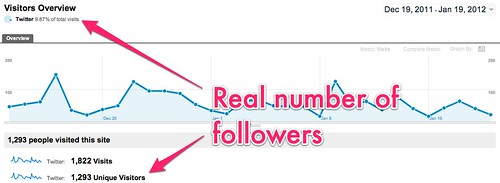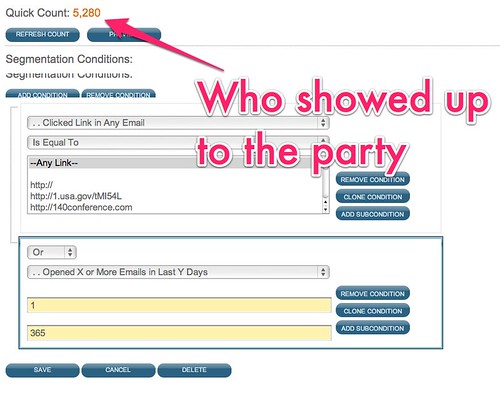Have you heard any of these questions lately:
What’s the value of a Facebook fan?
What’s the value of a Twitter follower?
What’s the value of an email subscriber?
I know I certainly have, and these are the wrong questions to be asking. Why? They assume that all people are the same. Let’s instead crib from Batman:
It’s not who I am underneath, but what I *do* that defines me.
There are, broadly speaking, two types of audience members: active and passive. Active members read your newsletters. They click on your tweets. They like your status updates on Facebook. They share with their networks. They read and forward your emails. They buy your products or services. They recommend you to other people.
Passive members… do nothing.
Here’s an example. I have, at the time of this writing, almost 49,000 followers. Awesome, right? I must be a social media success story. Not so fast. If I segment out the traffic on my website using Google Analytics’ Advanced Segments and ask me to show number of absolute unique visitors in the last 30 days from all things Twitter, the true number of followers I actually have that did the bare minimum of clicking on one link to my site in a month is:
1,293. That’s how many followers I have that actually showed up in the last month. That’s a pretty far cry from 49,000. Thankfully, there’s no cost to having the other 47,000+ in my network, but they’re basically dead weight that are providing nothing at all. It’s not like I’m asking them to buy a car or something, just click once on one link in 30 days in order to show up in the chart above.
Here’s another slice of life, my email list. Over 12,000 people subscribed. Great success story on the surface, but if we dig a little deeper…
Yep, less than half opened or clicked on ANYTHING in the last year. The rest of the list is dead weight, and I can and should just ditch ’em since most email companies charge based on the number of emails sent.
If you’re trying to figure out the value of a person in your audience, you’re barking up the wrong tree. A person in and of themselves has no value until they actually do something, anything, to show that you have some level of engagement with them. Active members of your audience have value. Passive members do not. Start by figuring out how many active members you have, and you will have a much better idea of how your social media efforts are actually performing.
You might also enjoy:
- Almost Timely News, January 7, 2024: Should You Buy a Custom GPT?
- Almost Timely News: Recipes vs. Principles in Generative AI (2024-03-03)
- Almost Timely News: Principles-Based Prompt Engineering (2024-02-25)
- You Ask, I Answer: Legality of Works in Custom GPTs?
- Almost Timely News, February 11, 2024: How To Evaluate a Generative AI System
Want to read more like this from Christopher Penn? Get updates here:
 Take my Generative AI for Marketers course! |




Leave a Reply